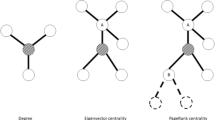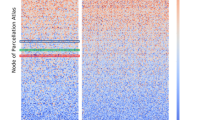Abstract
Purpose
Applying graph theory to the human brain has the potential to help prognosticate the impacts of intracerebral surgery. Eigenvector (EC) and PageRank (PR) centrality are two related, but uniquely different measures of nodal centrality which may be utilized together to reveal varying neuroanatomical characteristics of the brain connectome.
Methods
We obtained diffusion neuroimaging data from a healthy cohort (UCLA consortium for neuropsychiatric phenomics) and applied a personalized parcellation scheme to them. We ranked parcels based on weighted EC and PR, and then calculated the difference (EP difference) and correlation between the two metrics. We also compared the difference between the two metrics to the clustering coefficient.
Results
While EC and PR were consistent for top and bottom ranking parcels, they differed for mid-ranking parcels. Parcels with a high EC centrality but low PR tended to be in the medial temporal and temporooccipital regions, whereas PR conferred greater importance to multi-modal association areas in the frontal, parietal and insular cortices. The EP difference showed a weak correlation with clustering coefficient, though there was significant individual variation.
Conclusions
The relationship between PageRank and eigenvector centrality can identify distinct topological characteristics of the brain connectome such as the presence of unimodal or multimodal association cortices. These results highlight how different graph theory metrics can be used alone or in combination to reveal unique neuroanatomical features for further clinical study.




Similar content being viewed by others
Data availability
The authors declare that the data supporting the findings of this study are available within the article and its supplementary information files.
Code availability
The code and software used in the current study is proprietary.
References
Hervey-Jumper SL, Li J, Lau D, Molinaro AM, Perry DW, Meng L, Berger MS (2015) Awake craniotomy to maximize glioma resection: methods and technical nuances over a 27-year period. J Neurosurg 123:325–339. doi:https://doi.org/10.3171/2014.10.Jns141520
Spetzler RF, Martin NA (1986) A proposed grading system for arteriovenous malformations. J Neurosurg 65:476–483. doi:https://doi.org/10.3171/jns.1986.65.4.0476
Stopa BM, Senders JT, Broekman MLD, Vangel M, Golby AJ (2020) Preoperative functional MRI use in neurooncology patients: a clinician survey. NeuroSurg Focus 48:E11. doi:https://doi.org/10.3171/2019.11.Focus19779
Silva MA, See AP, Essayed WI, Golby AJ, Tie Y (2018) Challenges and techniques for presurgical brain mapping with functional MRI. NeuroImage Clin 17:794–803. https://doi.org/10.1016/j.nicl.2017.12.008
Dadario NB, Brahimaj B, Yeung J, Sughrue ME (2021) Reducing the cognitive footprint of brain tumor surgery. Front Neurol 12:711646. https://doi.org/10.3389/fneur.2021.711646
Mandonnet E, Cerliani L, Siuda-Krzywicka K, Poisson I, Zhi N, Volle E, De Schotten M (2017) A network-level approach of cognitive flexibility impairment after surgery of a right temporo-parietal glioma. Neurochirurgie 63:308–313
Yeung JT, Taylor HM, Young IM, Nicholas PJ, Doyen S, Sughrue ME (2021) Unexpected hubness: a proof-of-concept study of the human connectome using pagerank centrality and implications for intracerebral neurosurgery. J Neurooncol 151:249–256. doi:https://doi.org/10.1007/s11060-020-03659-6
Duffau H, Moritz-Gasser S, Mandonnet E (2014) A re-examination of neural basis of language processing: proposal of a dynamic hodotopical model from data provided by brain stimulation mapping during picture naming. Brain Lang 131:1–10. doi:https://doi.org/10.1016/j.bandl.2013.05.011
Zhou S (2021) Research on local topology tracking of power grid based on graph theory. Secur Commun Netw 2021:7027907. https://doi.org/10.1155/2021/7027907
Alonso M, Turanzas J, Amaris H, Ledo AT (2021) Cyber-physical vulnerability assessment in smart grids based on multilayer complex networks. Sensors. https://doi.org/10.3390/s21175826
Newman MEJ (2001) The structure of scientific collaboration networks. Proc Natl Acad Sci 98:404–409. https://doi.org/10.1073/pnas.98.2.404
Jeong H, Tombor B, Albert R, Oltvai ZN, Barabási A-L (2000) The large-scale organization of metabolic networks. Nature 407:651–654
Bullmore E, Sporns O (2009) Complex brain networks: graph theoretical analysis of structural and functional systems. Nat Rev Neurosci 10:186–198. doi:https://doi.org/10.1038/nrn2575
Briggs RG, Conner AK, Baker CM, Burks JD, Glenn CA, Sali G, Battiste JD, O’Donoghue DL, Sughrue ME (2018) A connectomic Atlas of the human cerebrum-chapter 18: the connectional anatomy of human brain networks. Oper Neurosurg 15:S470–S480. https://doi.org/10.1093/ons/opy272
Rubinov M, Sporns O (2010) Complex network measures of brain connectivity: uses and interpretations. NeuroImage 52:1059–1069. https://doi.org/10.1016/j.neuroimage.2009.10.003
Farahani FV, Karwowski W, Lighthall NR (2019) Application of graph theory for identifying connectivity patterns in human brain networks: a systematic review. Front Neurosci 13:585. https://doi.org/10.3389/fnins.2019.00585
Hart MG, Ypma RJF, Romero-Garcia R, Price SJ, Suckling J (2016) Graph theory analysis of complex brain networks: new concepts in brain mapping applied to neurosurgery. J Neurosurg 124:1665–1678. https://doi.org/10.3171/2015.4.JNS142683
van den Heuvel MP, Sporns O (2011) Rich-club organization of the human connectome. J Neurosci 31:15775–15786
Oldham S, Fulcher B, Parkes L, Arnatkevic̆iūtė A, Suo C, Fornito A (2019) Consistency and differences between centrality measures across distinct classes of networks. PLoS ONE 14:e0220061. doi:https://doi.org/10.1371/journal.pone.0220061
Ahsan SA, Chendeb K, Briggs RG, Fletcher LR, Jones RG, Chakraborty AR, Nix CE, Jacobs CC, Lack AM, Griffin DT, Teo C, Sughrue ME (2020) Beyond eloquence and onto centrality: a new paradigm in planning supratentorial neurosurgery. J Neurooncol 146:229–238. doi:https://doi.org/10.1007/s11060-019-03327-4
Senanayake U, Piraveenan M, Zomaya A (2015) The pagerank-index: going beyond citation counts in quantifying scientific impact of researchers. PLoS ONE 10:e0134794
Gorgolewski K, Durnez J, Poldrack R (2017) Preprocessed consortium for neuropsychiatric phenomics dataset. F1000Res. https://doi.org/10.12688/f1000research.11964.2
Doyen S, Nicholas P, Poologaindran A, Crawford L, Young IM, Romero-Garcia R, Sughrue ME (2021) Connectivity-based parcellation of normal and anatomically distorted human cerebral cortex. Hum Brain Mapp. doi:https://doi.org/10.1002/hbm.25728
Glasser MF, Coalson TS, Robinson EC, Hacker CD, Harwell J, Yacoub E, Ugurbil K, Andersson J, Beckmann CF, Jenkinson M, Smith SM, Van Essen DC (2016) A multi-modal parcellation of human cerebral cortex. Nature 536:171–178. doi:https://doi.org/10.1038/nature18933
Yeo BTT, Krienen FM, Sepulcre J, Sabuncu MR, Lashkari D, Hollinshead M, Roffman JL, Smoller JW, Zöllei L, Polimeni JR, Fischl B, Liu H, Buckner RL (2011) The organization of the human cerebral cortex estimated by intrinsic functional connectivity. J Neurophysiol 106:1125–1165. doi:https://doi.org/10.1152/jn.00338.2011
Sandhu Z, Tanglay O, Young IM, Briggs RG, Bai MY, Larsen ML, Conner AK, Dhanaraj V, Lin YH, Hormovas J, Fonseka RD, Glenn CA, Sughrue ME (2021) Parcellation-based anatomic modeling of the default mode network. Brain Behav 11:e01976. doi:https://doi.org/10.1002/brb3.1976
Akiki TJ, Abdallah CG (2019) Determining the hierarchical architecture of the human brain using subject-level clustering of functional networks. Sci Rep 9:19290. https://doi.org/10.1038/s41598-019-55738-y
Coomans MB, van der Linden SD, Gehring K, Taphoorn MJB (2019) Treatment of cognitive deficits in brain tumour patients: current status and future directions. Curr Opin Oncol 31:540–547. doi:https://doi.org/10.1097/CCO.0000000000000581
Duffau H, Capelle L, Denvil D, Sichez N, Gatignol P, Lopes M, Mitchell M-C, Sichez J-P, Van Effenterre P (2003) Functional recovery after surgical resection of low grade gliomas in eloquent brain: hypothesis of brain compensation. J Neurol Neurosurg Psychiatr 74:901–907. https://doi.org/10.1136/jnnp.74.7.901
Herbet G (2021) Should complex cognitive functions be mapped with direct electrostimulation in wide-awake surgery? A network perspective. Front Neurol. https://doi.org/10.3389/fneur.2021.635439
Sporns O (2018) Graph theory methods: applications in brain networks. Dialogues Clin Neurosci 20:111–121. doi:https://doi.org/10.31887/DCNS.2018.20.2/osporns
Hansen DL, Shneiderman B, Smith MA, Himelboim I (2020) Chapter 3—social network analysis: measuring, mapping, and modeling collections of connections. In: Hansen DL, Shneiderman B, Smith MA, Himelboim I (eds) Analyzing social media networks with NodeXL, 2nd edn. Morgan Kaufmann, Burlington, pp 31–51
Brin S, Page L (1998) The anatomy of a large-scale hypertextual web search engine. Comput Netw ISDN Syst 30:107–117. https://doi.org/10.1016/S0169-7552(98)00110-X
Bonacich P (1972) Factoring and weighting approaches to status scores and clique identification. J Math Sociol 2:113–120. doi:https://doi.org/10.1080/0022250X.1972.9989806
Zuo X-N, Ehmke R, Mennes M, Imperati D, Castellanos FX, Sporns O, Milham MP (2011) Network centrality in the human functional connectome. Cereb Cortex 22:1862–1875. https://doi.org/10.1093/cercor/bhr269
Margulies DS, Ghosh SS, Goulas A, Falkiewicz M, Huntenburg JM, Langs G, Bezgin G, Eickhoff SB, Castellanos FX, Petrides M, Jefferies E, Smallwood J (2016) Situating the default-mode network along a principal gradient of macroscale cortical organization. Proc Natl Acad Sci 113:12574–12579. https://doi.org/10.1073/pnas.1608282113
Baker CM, Burks JD, Briggs RG, Stafford J, Conner AK, Glenn CA, Sali G, McCoy TM, Battiste JD, O’Donoghue DL, Sughrue ME (2018) A connectomic Atlas of the human cerebrum-chapter 9: the occipital lobe. Oper Neurosurg 15:S372–S406. https://doi.org/10.1093/ons/opy263
Insausti R, Amaral D (2004) Hippocampal formation. Hum Nerv Syst 2:871–914
Aminoff EM, Kveraga K, Bar M (2013) The role of the parahippocampal cortex in cognition. Trends Cogn Sci 17:379–390. doi:https://doi.org/10.1016/j.tics.2013.06.009
Visser M, Jefferies E, Embleton KV, Lambon Ralph MA (2012) Both the middle temporal gyrus and the ventral anterior temporal area are crucial for multimodal semantic processing: distortion-corrected fMRI evidence for a double gradient of information convergence in the temporal lobes. J Cogn Neurosci 24:1766–1778
du Boisgueheneuc F, Levy R, Volle E, Seassau M, Duffau H, Kinkingnehun S, Samson Y, Zhang S, Dubois B (2006) Functions of the left superior frontal gyrus in humans: a lesion study. Brain 129:3315–3328. doi:https://doi.org/10.1093/brain/awl244
Coen SJ, Hobson AR, Aziz Q (2012) Chapter 23—processing of gastrointestinal sensory signals in the brain. In: Johnson LR, Ghishan FK, Kaunitz JD, Merchant JL, Said HM, Wood JD (eds) Physiology of the gastrointestinal tract, 5th edn. Academic Press, Boston, pp 689–702
Davidson PSR, Anaki D, Ciaramelli E, Cohn M, Kim ASN, Murphy KJ, Troyer AK, Moscovitch M, Levine B (2008) Does lateral parietal cortex support episodic memory? Evidence from focal lesion patients. Neuropsychologia 46:1743–1755. doi:https://doi.org/10.1016/j.neuropsychologia.2008.01.011
Meunier D, Lambiotte R, Fornito A, Ersche KD, Bullmore ET (2009) Hierarchical modularity in human brain functional networks. Front Neuroinform 3:37–37. doi:https://doi.org/10.3389/neuro.11.037.2009
Fornito A, Zalesky A, Breakspear M (2015) The connectomics of brain disorders. Nat Rev Neurosci 16:159–172. doi:https://doi.org/10.1038/nrn3901
Liang X, Zou Q, He Y, Yang Y (2013) Coupling of functional connectivity and regional cerebral blood flow reveals a physiological basis for network hubs of the human brain. Proc Natl Acad Sci 110:1929–1934. https://doi.org/10.1073/pnas.1214900110
Aben HP, Biessels GJ, Weaver NA, Spikman JM, Visser-Meily JMA, de Kort PLM, Reijmer YD (2019) Extent to which network hubs are affected by ischemic stroke predicts cognitive recovery. Stroke 50:2768–2774. https://doi.org/10.1161/strokeaha.119.025637
Tononi G, Sporns O, Edelman GM (1999) Measures of degeneracy and redundancy in biological networks. Proc Natl Acad Sci 96:3257–3262. https://doi.org/10.1073/pnas.96.6.3257
Funding
No funding was received for conducting this study.
Author information
Authors and Affiliations
Contributions
OT, SD and MES contributed to the study conception and design. Material preparation, data collection and analysis were performed by HMT, PJN, and OT. The first draft of the manuscript was written by OT and IMY and all authors commented on previous versions of the manuscript. The edited and revised draft of the manuscript was written by ND and OT. All authors read and approved the final manuscript.
Corresponding author
Ethics declarations
Conflict of interest
Isabella M. Young, Hugh M. Taylor, Peter J. Nicholas, Stéphane Doyen, and Michael E. Sughrue are employees of and shareholders in Omniscient Neurotechnology. Onur Tanglay is an employee of Omniscient Neurotechnology. Nicholas B. Dadario has no disclosures.
Ethical approval
The data used in the study are from a publicly available dataset. The procedures in the original study were approved by the Institutional Review Boards at UCLA and the Los Angeles Country Department of Mental Health.
Additional information
Publisher’s Note
Springer Nature remains neutral with regard to jurisdictional claims in published maps and institutional affiliations.
Electronic Supplementary Material
Below is the link to the electronic supplementary material.
11060_2021_3935_MOESM1_ESM.docx
Supplementary file1 Supplementary Results. The PageRank, Eigenvector, EP Difference, and Clustering Coefficient ranks for each parcel across 81 subjects (DOCX 218 kb)
11060_2021_3935_MOESM2_ESM.xlsx
Supplementary file2 Supplementary Methods. A description of the imaging pre-processing pipeline and the creation of the personalized parcellation scheme (XLSX 1389 kb)
Rights and permissions
About this article
Cite this article
Tanglay, O., Young, I.M., Dadario, N.B. et al. Eigenvector PageRank difference as a measure to reveal topological characteristics of the brain connectome for neurosurgery. J Neurooncol 157, 49–61 (2022). https://doi.org/10.1007/s11060-021-03935-z
Received:
Accepted:
Published:
Issue Date:
DOI: https://doi.org/10.1007/s11060-021-03935-z




